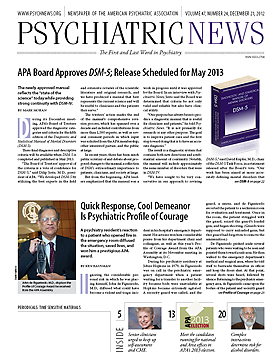Infant brain development, therapeutic strategies for bulimia nervosa, and antidepressants and depression during pregnancy.
These were among the subjects of seven articles chosen by the editors to highlight in this month’s American Journal of Psychiatry (AJP) as especially interesting and clinically important articles that appeared in the journal in 2012. Making the selection were Editor Robert Freedman, M.D., and Deputy Editors Daniel Pine, M.D., Carol Tamminga, M.D., Susan Schultz, M.D., Robert Michels, M.D., and David Lewis, M.D.
This annual review is a regular feature in the December issue of the journal. Also making its debut in this month's journal is a Spanish-translation service that presents the “2012 in Review” editorial in Spanish.
In the article “Differences in White Matter Fiber Tract Development Present From 6 to 24 Months in Infants With Autism,” Jason Wolff, Ph.D., and colleagues assessed 92 infants at risk for autism by using diffusion tensor imaging, then used these data to compare brain development in 28 infants who ultimately met criteria for autism with the 64 who did not. Findings suggest that signs of autism manifest in the brain before clinical symptoms are readily apparent. Deputy Editor Daniel Pine, M.D., said the findings “allow clinicians and neuroscientists to join in their search for signs of abnormal infant development,” a joint search that “provides a nidus around which attempts to develop novel treatment might converge.” The study was published in June.
In “The Changing ‘Weightscape’ of Bulimia Nervosa” (October), Cynthia Bulik, Ph.D., and colleagues highlighted the complex influence of obesity on the treatment of bulimia nervosa, focusing on a case example of a young woman with a body mass index of 38. Rather than the standard cognitive-behavioral therapy (CBT) that may typically be used for bulimia nervosa, the patient instead participated in a modified CBT program that allowed her to set personalized goals that included a physical exercise regimen. Deputy Editor Susan Schultz, M.D., called the article “a superb example of reaching beyond the traditional symptom-focused approach to address important health concerns and comorbid obesity.”
In the article “Neurodevelopment of Children Following Prenatal Exposure to Venlafaxine, Selective Serotonin Reuptake Inhibitors, or Untreated Maternal Depression” (November), Irena Nulman, M.D., and colleagues studied the effect of antidepressant drugs and/or maternal depression on long-term child neurodevelopment. They analyzed children whose mothers took antidepressants during pregnancy, had untreated depression during pregnancy, or were healthy with no treatment. The children exposed to maternal depression had lower IQs and more problem behaviors than the healthy group's children, but these outcomes correlated with the extent of the maternal depression, not with the dose or duration of the antidepressant medication. “Treatment of depression really matters, and children can be adversely affected—but by the disease, not the antidepressant,” wrote Deputy Editor Carol Tamminga, M.D.
Other articles chosen by the editors included “Risk Adjustment in Health Insurance Exchanges for Individuals With Mental Illness” (July) by Colleen Barry, Ph.D., and colleagues; “Combined Cognitive Remediation and Functional Skills Training for Schizophrenia: Effects on Cognition, Functional Competence, and Real-World Behavior” (July) by Christopher Bowie, Ph.D., and colleagues; “A Quality-Based Review of Randomized, Controlled Trials of Cognitive-Behavioral Therapy for Depression: An Assessment and Metaregression” (January) by Nathan Thoma, Ph.D., and colleagues; and “ ‘Bath Salts’: Emergence of an Epidemic” (May) by George Loeffler, M.D. ■
